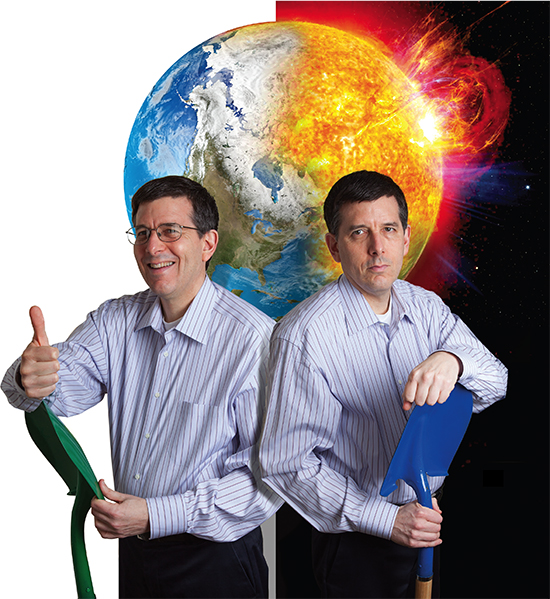




ABOUT THE AUTHOR:Adam Rome is a member of both the history and English departments at UD, and he teaches courses in environmental history and environmental non-fiction. His first book, The Bulldozer in the Countryside, won the Organization of American Historians' Frederick Jackson Turner Award. The Genius of Earth Day was published this past spring. Rome earned his B.A. from Yale and his Ph.D. from the University of Kansas.
I have two scholarly personalities. On the one hand, I am Dr. Earth Day. I study the history of environmental activism in the United States, and I think much of that history is heartening: Since the mid-19th century, a growing number of Americans have fought to control pollution, conserve natural resources, and protect wild places and creatures.
On the other hand, I am Mr. Apocalypse. Despite all that environmental activists have accomplished in the last 150 years, we still face potentially devastating environmental problems, and I am keen to explain why that's true.
At the start of my career, Dr. Earth Day and Mr. Apocalypse worked so closely together that I didn't appreciate the split. My first book, The Bulldozer in the Countryside: Suburban Sprawl and the Rise of American Environmentalism, was a story of both success and failure.
The heart of the book tells how homeowners, experts and government officials began to decry the environmental costs of the explosive growth of suburbia after World War II. Septic tanks failed, and suburbanites were shocked to see detergent foam flowing from kitchen faucets. Home construction on steep hills led to deadly landslides. Eroded soil from tract-house construction sites silted up nearby lakes. For many reasons, floods became more frequent in fast-developing areas.
In every case, the critics sought government action to address the problems they saw. The result was an unprecedented effort in the 1960s to protect open space and regulate development. That was the good news in the book. But of course sprawl did not stop in 1970—or 1980 or 1990 or 2000. That was the bad news. In my conclusion, I considered why Americans haven't done more to support green development.
Though Dr. Earth Day and Mr. Apocalypse cooperated for a time, they soon went their separate ways. In my second book, my booster personality took charge. I decided to write a history of the first Earth Day, and the story turned out to be even more amazing than I expected. In September 1969, Senator Gaylord Nelson of Wisconsin promised to organize "a nationwide teach-in on the environment" in the spring 1970, and his call to action ultimately inspired more than 12,000 Earth Day celebrations across the nation.
Those events had a freshness and intensity that are difficult to imagine today. Because Earth Day 1970 was unprecedented, the organizers had to plan everything from scratch, and the organizing work often was life-changing.
Tens of thousands of people spoke on Earth Day—and many had never spoken publicly about environmental issues before. The discussions at Earth Day teach-ins sometimes were soul-searching: Many participants were struggling to get to the roots of "the environmental crisis."
The events truly made history. Earth Day built a lasting eco-infrastructure—national and state lobbying organizations, environmental studies programs, environmental beats at newspapers, eco-sections in bookstores, community ecology centers. Thousands of organizers and participants decided to devote their lives to the environmental cause. Earth Day gave birth to the first green generation.
But every day is not Earth Day, as Mr. Apocalypse likes to say. After five years of feel-good research, I now am ready to let my darker personality be my muse. My third book aims to answer a simple yet discomfiting question: Why do we have environmental problems?
Some of the reasons are quite recent, and some go back a long time. We accept environmental degradation as the price of progress. For centuries, most Americans believed that taming the wilderness was a religious and patriotic duty, and that idea still has considerable power. We have come to imagine that "nature" is just a small group of amenities, not the complex totality that sustains all life. The culture of consumerism encourages us to have infinite desires—and those desires press harder and harder on a finite planet. We believe that the world is ours to use as we see fit: We are the Lords of Creation. Though we love some aspects of nature, we hate others, and we have worked relentlessly to destroy the elements of nature that we find hateful. We value the Earth primarily as a source of wealth.
That list is just a start, so the biggest challenge of the project will be picking the most important reasons why we have environmental problems.
And then what? I'm sure that Dr. Earth Day and Mr. Apocalypse will pull me this way and that way when I begin to ponder a fourth book. At least both personalities are constructive. Because the environmental challenges we face often seem overwhelming, we need the kind of hope that Dr. Earth Day offers. But we also need to see clearly what's wrong, and pointing to difficult truths is the forte of Mr. Apocalypse. Though having multiple personalities isn't usually ideal, I can't complain.